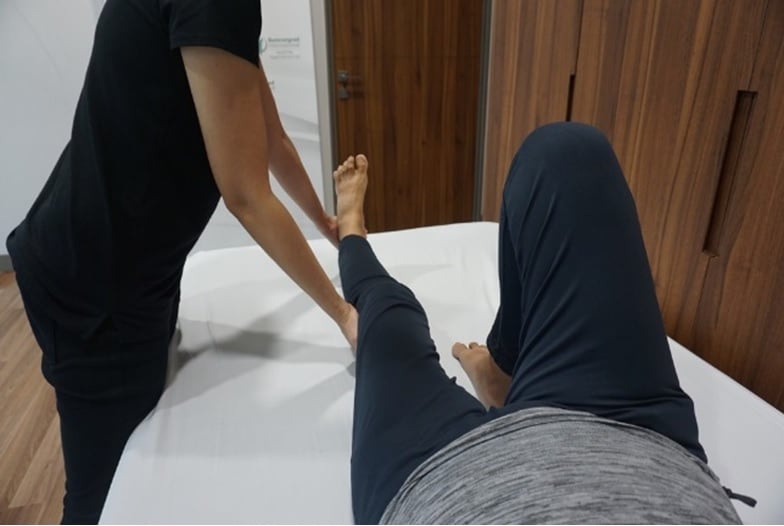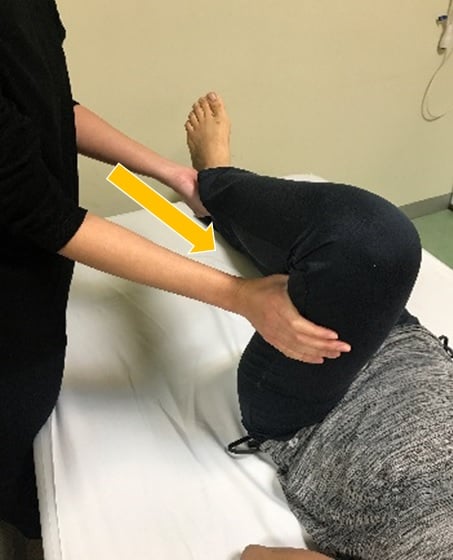- Inform the elderly patient each time before moving, providing brief and easy-to-understand instructions.
- Before moving, the caregiver should be close to the patient and positioned on the side to which the patient will be moved or turned.
- Hold the upper or lower part of the body that will be moved, using it as a control point for movement, such as the shoulder or ankle.
1. Moving the elderly patient
1.1 Moving in bed
How to move: The patient should lie flat on their back. The caregiver should ask the patient to bend both elbows and lift both knees. To move the patient to the right or left side, instruct the patient to press both elbows and feet firmly on the bed while lifting the shoulder toward the desired direction. Slowly shift the body and hips accordingly. To move the patient up or down, ask the patient to press both elbows and feet firmly on the bed while lifting the shoulder either up or down, and then slowly move the body and hips accordingly. If the patient is weak, the caregiver may assist by pulling the edge of the bedsheet or using both hands to lift under the shoulder blades or hips to support and help move the patient.
1.2 Sit to stand
How to move: Have the patient sit at the edge of the bed with their ankles positioned behind their knees. The knees should be slightly apart. Instruct the patient to lean forward gently, shift their weight onto both feet, slowly straighten the knees, and lift the body up while keeping their eyes looking straight ahead.
1.3 From wheelchair to bed
How to move: While the patient is seated in the wheelchair, the caregiver positions the wheelchair at a 45-degree angle to the bed, ensuring that the stronger side is closer to the bed. Lock the wheelchair. Ask the patient to scoot forward in the seat. The caregiver should stand in front of the patient, placing one hand under the patient's armpit and the other supporting the patient's lower back. Instruct the patient to press both hands on the armrests, then slowly stand up, turn so their back faces the bed, and carefully lower themselves to sit on the bed.
1.4 Walking support
How to move: The patient stands upright. The caregiver fastens a belt around the patient’s waist for support. Ask the patient to hold onto one of the caregiver’s arms, while the caregiver uses the other arm to hold the belt. The caregiver should stand slightly behind the patient and control the pace of walking. The patient should keep their body upright and look straight ahead throughout the walk.
2. Getting up from the floor after a fall
Step-by-step instructions:
2.1 Do not panic. Assess any injuries and slowly attempt to move. If you are seriously injured or unable to move, call for help immediately.
2.2 Slowly bend your knees, push yourself up with your elbow, and turn towards the uninjured side.
2.3 Sit up on either side, propping yourself on your elbow, or have the caregiver assist in supporting you.
2.4 Slowly turn into a crawling position and crawl towards the nearest bed or chair. Carefully place both hands on the bed or chair, and then gradually move into a kneeling position.
2.5 Use both hands and feet to push, straighten your knees, and gradually stand up. Turn your body to sit on the bed or chair. Sit and rest for a moment. Do not stand or walk immediately.
3. Exercising to prevent joint stiffness
Caution: Stretch to a point where there is no pain, hold for 10 seconds, and repeat 3-5 times.
3.1 Arm lift
How to: The patient lies on their back with both arms resting at the sides. The caregiver lifts the patient's arm above the head and slowly lowers it back down.
3.2 Arm open
How to: The patient lies on their back with both arms resting at their sides. The caregiver gently opens the patient's arms away from the body, ensuring the palms remain facing the body. Slowly bring the arms back to the sides.
3.3 Breathing exercise with chest movement using a walking cane
How to: The patient should sit up straight without hunching the shoulders. The caregiver instructs the patient to hold the cane with both hands and lift it above the head without shrugging the shoulders. The caregiver may or may not support the cane. While lifting the cane, take a slow, deep breath into the abdomen, and when lowering the cane, slowly exhale through the mouth. Repeat 5-10 times.
3.4 Elbow flexing and extension
How to: The patient lies on their back with the arms slightly extended. The caregiver moves the patient's arm to flex the elbow and holds the position for 10 seconds. Then, slowly extend the elbow and hold for another 10 seconds, ensuring the position is not painful for the patient.
3.5 Knee and hip bending
How to: The patient lies on their back. The caregiver holds under the ankle of the leg to be moved with one hand and under the knee of the same leg with the other hand. Gently bend the knee and hip upwards, then slowly return to the starting position. Repeat on the other side.
 |
 |
3.6 Hip abduction
How to: The patient lies on their back. The caregiver holds under the knee of the leg to be moved with one hand and under the ankle of the same leg with the other hand. Gently move the hip outward to the side, then slowly return to the starting position. Repeat on the other side.
4. Exercising to enhance bone and muscle strength using body weight
4.1 Glute bridge
How to: The patient lies on their back with both knees bent. Instruct the patient to tighten their lower abdomen and squeeze their glutes. Slowly lift the hips off the ground to a position where there is no pain, making sure not to hold the breath. Slowly return to the starting position. Repeat 10 times.
4.2 Leg kicking with sandbag
How to: The patient sits up straight. The caregiver wraps a sandbag around the leg to be exercised and instructs the patient to slowly lift the leg while straightening the knee. Ensure the position is not painful and that the patient does not hold their breath. Slowly return to the starting position. Repeat 10 times on each leg.
4.3 Arm lift with sandbag
How to: The patient sits up straight. The caregiver wraps a sandbag around the arm to be exercised and instructs the patient to slowly lift the arm. The caregiver may assist in lifting the arm above the head. Ensure the position is not painful and that the patient does not hold their breath. Slowly return to the starting position. Repeat 10 times on each side.
4.4 Bed press to assist with standing up
How to: The patient sits up straight with both feet flat on the floor. The caregiver instructs the patient to open their palms or make fists (if the wrists hurt) with both hands. Place the hands on the bed, and slowly push the body upward, holding the position for 1-5 seconds. Ensure the patient does not hold their breath and then slowly return to the starting position. Repeat 10 times.